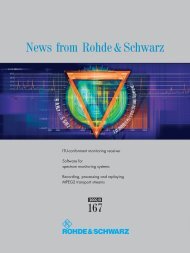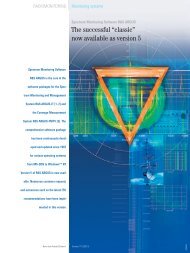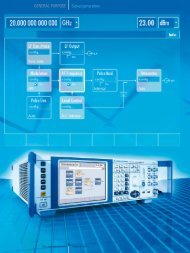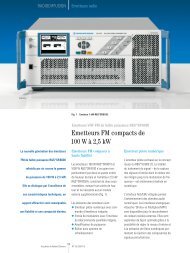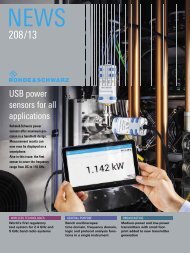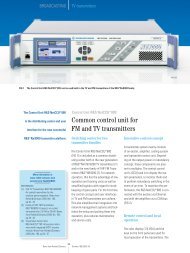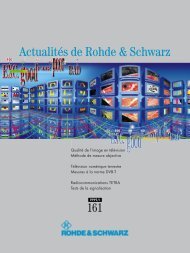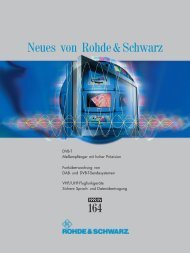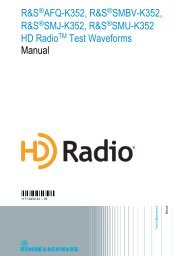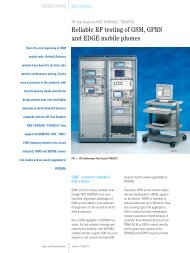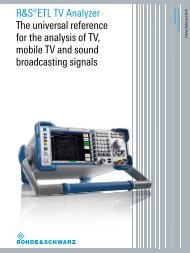- Page 1:
Test and MeasurementDivisionOperati
- Page 4 and 5:
Introduction on how to use the manu
- Page 7 and 8:
Safety InstructionsWARNINGDanger of
- Page 13 and 14:
ContentsSMIQ2.21 Arbitrary Waveform
- Page 15 and 16:
ContentsSMIQ3 Remote Control.......
- Page 17 and 18:
ContentsSMIQ3.7.4 Application of th
- Page 19 and 20:
ContentsSMIQ5.3.9.2 AM Distortion .
- Page 21 and 22:
ContentsSMIQC Annex C..............
- Page 23 and 24:
ContentsSMIQFiguresFig. 1-1 SMIQ, v
- Page 25 and 26:
ContentsSMIQFig. 2-81 Menu DIGITAL
- Page 27 and 28:
ContentsSMIQFig. 2-168 DIGITAL STD
- Page 29 and 30:
ContentsSMIQFig. 2-244 Menu MEM SEQ
- Page 31 and 32:
Switchover to Remote ControlSMIQ3.1
- Page 33 and 34:
MessagesSMIQ3.2.2 Remote Control vi
- Page 35 and 36:
Structure and Syntax of the Device
- Page 37 and 38:
Structure and Syntax of the Device
- Page 39 and 40:
Structure and Syntax of the Device
- Page 41 and 42:
Description of CommandsSMIQ3.5 Desc
- Page 43 and 44:
Description of CommandsSMIQ3.5.2 Co
- Page 45 and 46:
Description of CommandsSMIQ*PRE 0 t
- Page 47 and 48:
ARB SystemSMIQ3.5.4 ARB SystemRefer
- Page 49 and 50:
ARB SystemSMIQ:ARB:WAVeform:FREE?Th
- Page 51 and 52:
ARB SystemSMIQ:ARB:CLOCk:SOURce INT
- Page 53 and 54:
ARB SystemSMIQ{CLOCK: frequency}(in
- Page 55 and 56:
ARB SystemSMIQTo be read by the SMI
- Page 57 and 58:
ARB SystemSMIQC-program for creatin
- Page 59 and 60:
BERT SystemSMIQ3.5.5 BERT SystemCom
- Page 61 and 62:
BERT SystemSMIQ:BERT:SETup:DENable
- Page 63 and 64:
BLER SystemSMIQ3.5.6 BLER SystemCom
- Page 65 and 66:
BLER SystemSMIQ:BLER:RESult?This co
- Page 67 and 68:
CALibration SystemSMIQ:CALibration:
- Page 69 and 70:
DIAGnostic SystemSMIQ3.5.8 DIAGnost
- Page 71 and 72:
DIAGnostic SystemSMIQ:DIAGnostic:IN
- Page 73 and 74:
FORMat SystemSMIQ3.5.10 FORMat Syst
- Page 75 and 76:
OUTPut SystemSMIQ3.5.12 OUTPut Syst
- Page 77 and 78:
OUTPut2 SystemSMIQ3.5.13 OUTPut2 Sy
- Page 79 and 80:
SOURce:AM SubsystemSMIQ3.5.14.1 SOU
- Page 81 and 82:
SOURce:CORRection SubsystemSMIQ[:SO
- Page 83 and 84:
SOURce:DECT SubsystemSMIQCommand Pa
- Page 85 and 86:
SOURce:DECT SubsystemSMIQ[:SOURce]:
- Page 87 and 88:
SOURce:DECT SubsystemSMIQ[:SOURce]:
- Page 89 and 90:
SOURce:DECT SubsystemSMIQ[:SOURce]:
- Page 91 and 92:
SOURce:DIST SubsystemSMIQ[:SOURce]:
- Page 93 and 94:
SOURce:DIST SubsystemSMIQ[:SOURce]:
- Page 95 and 96:
SOURce:DM SubsystemSMIQ[:SOURce]:DM
- Page 97 and 98:
SOURce:DM SubsystemSMIQCommand Para
- Page 99 and 100:
SOURce:DM SubsystemSMIQ[:SOURce]:DM
- Page 101 and 102:
SOURce:DM SubsystemSMIQ[:SOURce]:DM
- Page 103 and 104:
SOURce:DM SubsystemSMIQ[:SOURce]:DM
- Page 105 and 106:
SOURce:DM SubsystemSMIQ[:SOURce]:DM
- Page 107 and 108:
SOURce:FM SubsystemSMIQ3.5.14.6 SOU
- Page 109 and 110:
SOURce:FREQuency SubsystemSMIQ3.5.1
- Page 111 and 112:
SOURce:FSIM-SubsystemSMIQ3.5.14.8 S
- Page 113 and 114:
SOURce:FSIM-SubsystemSMIQ[:SOURce]:
- Page 115 and 116:
SOURce:FSIM-SubsystemSMIQ[:SOURce]:
- Page 117 and 118:
SOURce:FSIM-SubsystemSMIQ[:SOURce]:
- Page 119 and 120:
SOURce:FSIM-SubsystemSMIQ[:SOURce]:
- Page 121 and 122:
SOURce:FSIM-SubsystemSMIQ[:SOURce]:
- Page 123 and 124:
SOURce:GPS SubsystemSMIQ[:SOURce]:G
- Page 125 and 126:
SOURce:GSM Subsystem (Digital Stand
- Page 127 and 128:
SOURce:GSM Subsystem (Digital Stand
- Page 129 and 130:
SOURce:GSM Subsystem (Digital Stand
- Page 131 and 132:
SOURce:IS95 Subsystem (Digital Stan
- Page 133 and 134:
SOURce:IS95 Subsystem (Digital Stan
- Page 135 and 136:
SOURce:IS95 Subsystem (Digital Stan
- Page 137 and 138:
SOURce:IS95 Subsystem (Digital Stan
- Page 139 and 140:
SOURce:LIST SubsystemSMIQ3.5.14.12
- Page 141 and 142:
SOURce:MARKer SubsystemSMIQ3.5.14.1
- Page 143 and 144:
SOURce:MODulation SubsystemSMIQ3.5.
- Page 145 and 146:
SOURce:NADC SubsystemSMIQCommand Pa
- Page 147 and 148:
SOURce:NADC SubsystemSMIQ[:SOURce]:
- Page 149 and 150:
SOURce:NADC SubsystemSMIQ[:SOURce]:
- Page 151 and 152:
SOURce:NADC SubsystemSMIQ[:SOURce]:
- Page 153 and 154:
SOURce:PDC SubsystemSMIQ3.5.14.17 S
- Page 155 and 156:
SOURce:PDC SubsystemSMIQ[:SOURce]:P
- Page 157 and 158:
SOURce:PDC SubsystemSMIQ[:SOURce]:P
- Page 159 and 160:
SOURce:PDC SubsystemSMIQ[:SOURce]:P
- Page 161 and 162:
SOURce:PDC SubsystemSMIQ[:SOURce]:P
- Page 163 and 164:
SOURce:PHS SubsystemSMIQ3.5.14.19 S
- Page 165 and 166:
SOURce:PHS SubsystemSMIQ[:SOURce]:P
- Page 167 and 168:
SOURce:PHS SubsystemSMIQ[:SOURce]:P
- Page 169 and 170:
SOURce:PHS SubsystemSMIQ[:SOURce]:P
- Page 171 and 172:
SOURce:PM SubsystemSMIQ3.5.14.20 SO
- Page 173 and 174:
SOURce:POWer SubsystemSMIQ3.5.14.21
- Page 175 and 176:
SOURce:POWer SubsystemSMIQ[:SOURce]
- Page 177 and 178:
SOURce:ROSCillator SubsystemSMIQ3.5
- Page 179 and 180:
SOURce:SWEep SubsystemSMIQ[:SOURce]
- Page 181 and 182:
SOURce:WCDMa Subsystem (NTT DoCoMo/
- Page 183 and 184:
SOURce:WCDMa Subsystem (NTT DoCoMo/
- Page 185 and 186:
SOURce:WCDMa Subsystem (NTT DoCoMo/
- Page 187 and 188:
SOURce:WCDMa Subsystem (NTT DoCoMo/
- Page 189 and 190:
SOURce:W3GPp-SubsystemSMIQCommand P
- Page 191 and 192:
SOURce:W3GPp-SubsystemSMIQCommand P
- Page 193 and 194:
SOURce:W3GPp-SubsystemSMIQ[:SOURce]
- Page 195 and 196:
SOURce:W3GPp-SubsystemSMIQ[:SOURce]
- Page 197 and 198:
SOURce:W3GPp-SubsystemSMIQ[:SOURce]
- Page 199 and 200:
SOURce:W3GPp-SubsystemSMIQ[:SOURce]
- Page 201 and 202:
SOURce:W3GPp-SubsystemSMIQ[:SOURce]
- Page 203 and 204:
SOURce:W3GPp-SubsystemSMIQ[:SOURce]
- Page 205 and 206:
SOURce:W3GPp-SubsystemSMIQ[:SOURce]
- Page 207 and 208:
SOURce:W3GPp-SubsystemSMIQ[:SOURce]
- Page 209 and 210:
SOURce:W3GPp:ENHanced/OCNS/ADDition
- Page 211 and 212:
SOURce:W3GPp:ENHanced/OCNS/ADDition
- Page 213 and 214:
SOURce:W3GPp:ENHanced/OCNS/ADDition
- Page 215 and 216:
SOURce:W3GPp:ENHanced/OCNS/ADDition
- Page 217 and 218:
SOURce:W3GPp:ENHanced/OCNS/ADDition
- Page 219 and 220:
SOURce:W3GPp:ENHanced/OCNS/ADDition
- Page 221 and 222:
SOURce:W3GPp:ENHanced/OCNS/ADDition
- Page 223 and 224:
SOURce2:FREQuency SubsystemSMIQ3.5.
- Page 225 and 226:
SOURce2:MARKer SubsystemSMIQ3.5.15.
- Page 227 and 228:
SOURce2:SWEep SubsystemSMIQ:SOURce2
- Page 229 and 230:
STATus SystemSMIQ:STATus:OPERation:
- Page 231 and 232:
SYSTem SystemSMIQ:SYSTem:BEEPer:STA
- Page 233 and 234:
SYSTem SystemSMIQ:SYSTem:MSEQuence:
- Page 235:
SYSTem SystemSMIQ:SYSTem:SERRor?Thi
- Page 238:
SMIQTEST System:TEST:MCOD?The comma
- Page 242 and 243:
SMIQTRIGger System:TRIGger:MSEQuenc
- Page 244 and 245:
SMIQInstrument Model and Command Pr
- Page 246 and 247:
SMIQInstrument Model and Command Pr
- Page 248 and 249:
SMIQStatus Reporting SystemCONDitio
- Page 250 and 251:
SMIQStatus Reporting System3.7.3 De
- Page 252 and 253:
SMIQStatus Reporting System3.7.3.4
- Page 254 and 255:
SMIQStatus Reporting System3.7.4 Ap
- Page 256 and 257: SMIQStatus Reporting System3.7.5 Re
- Page 258 and 259: SMIQFast Restore Mode3.8.2 Call-Up
- Page 260 and 261: SMIQMaintenance and Troubleshooting
- Page 262 and 263: SMIQTest Equipment and Test Assembl
- Page 264 and 265: SMIQTest Equipment and Test Assembl
- Page 266 and 267: SMIQTest Equipment and Test Assembl
- Page 268 and 269: SMIQPreparation, Recommended Test F
- Page 270 and 271: SMIQTest Procedures5.3.2.2 Settling
- Page 272 and 273: SMIQTest Procedures5.3.2.3 Setting
- Page 274 and 275: SMIQTest ProceduresRecommended test
- Page 276 and 277: SMIQTest ProceduresPassive measurem
- Page 278 and 279: SMIQTest Procedures5.3.4.4 Non-Inte
- Page 280 and 281: SMIQTest Procedures5.3.5.2 Subharmo
- Page 282 and 283: SMIQTest ProceduresNonharmonics of
- Page 284 and 285: SMIQTest Procedures5.3.5.5 SSB Phas
- Page 286 and 287: SMIQTest Procedures5.3.7 Internal M
- Page 288 and 289: SMIQTest Procedures5.3.8.3 Error Ve
- Page 290 and 291: SMIQTest Procedures5.3.8.6 I/Q Imba
- Page 292 and 293: SMIQTest Procedures5.3.9 Amplitude
- Page 294 and 295: SMIQTest Procedures5.3.10 Broadband
- Page 296 and 297: SMIQTest Procedures5.3.12.3 FM Freq
- Page 298 and 299: SMIQTest Procedures5.3.12.7 Level M
- Page 300 and 301: SMIQTest Procedures5.3.14.2 Analog
- Page 302 and 303: SMIQTest Procedures5.3.15 Data Gene
- Page 304 and 305: SMIQTest ProceduresSELECT CONTROL L
- Page 308 and 309: SMIQTest ProceduresEDGE measurement
- Page 310 and 311: SMIQTest Procedures The adjacent-ch
- Page 312 and 313: SMIQTest Procedures5.3.17 IS-95 CDM
- Page 314 and 315: SMIQTest Procedures5.3.19 3GPP W-CD
- Page 316 and 317: SMIQTest Procedures Settings on dem
- Page 318 and 319: SMIQTest Procedures For 5 MHz offse
- Page 320 and 321: SMIQTest Procedures Channel table:-
- Page 322 and 323: SMIQTest ProceduresCHNO CHAN. CODE
- Page 324 and 325: SMIQTest Procedures Menu Select BS/
- Page 326 and 327: SMIQTest Procedures5.3.23.2 Additio
- Page 328 and 329: SMIQTest Procedures The result is a
- Page 330 and 331: SMIQTest Procedures5.3.23.6 Doppler
- Page 332 and 333: SMIQTest Procedures5.3.24.2 Additio
- Page 334 and 335: SMIQTest Procedures5.3.24.5 Signal/
- Page 336 and 337: SMIQTest Procedures5.3.24.6 Signal/
- Page 338 and 339: SMIQTest Procedures5.3.25 Arbitrary
- Page 340 and 341: SMIQTest Procedures5.3.25.4 Level D
- Page 342 and 343: SMIQTest ProceduresExample of a mea
- Page 344 and 345: SMIQPerformance Test ReportSection
- Page 346 and 347: SMIQPerformance Test ReportSection
- Page 348 and 349: SMIQIEC/IEEE Bus InterfaceAAnnex AA
- Page 350 and 351: SMIQIEC/IEEE Bus InterfaceA.1.4Inte
- Page 352 and 353: SMIQRS-232-C InterfaceA.2.2.1Transm
- Page 354: SMIQAsynchronous Interface SERDATAA
- Page 357 and 358:
List of Error MessagesSMIQContinuat
- Page 359 and 360:
List of Error MessagesSMIQDevice Sp
- Page 361 and 362:
List of Error MessagesSMIQContinuat
- Page 363 and 364:
List of Error MessagesSMIQContinuat
- Page 366 and 367:
SMIQList of CommandsCAnnex CC.1 Lis
- Page 368 and 369:
SMIQList of CommandsCommand Paramet
- Page 370 and 371:
SMIQList of CommandsCommand Paramet
- Page 372 and 373:
SMIQList of CommandsCommand Paramet
- Page 374 and 375:
SMIQList of CommandsCommand Paramet
- Page 376 and 377:
SMIQList of CommandsCommand Paramet
- Page 378 and 379:
SMIQList of CommandsCommand Paramet
- Page 380 and 381:
SMIQList of CommandsCommand Paramet
- Page 382 and 383:
SMIQList of CommandsCommand Paramet
- Page 384 and 385:
SMIQList of CommandsCommand Paramet
- Page 386 and 387:
SMIQList of CommandsCommand Paramet
- Page 388 and 389:
SMIQList of CommandsCommand Paramet
- Page 390 and 391:
SMIQProgramming ExamplesDAnnex DD.1
- Page 392 and 393:
SMIQProgramming Examples6. List Man
- Page 394:
SMIQProgramming ExamplesReading out
- Page 397 and 398:
IndexSMIQvalue range ..............
- Page 399 and 400:
IndexSMIQDisplaybrightness.........
- Page 401 and 402:
IndexSMIQBIT CLOCK ................
- Page 403 and 404:
IndexSMIQadditional................
- Page 405 and 406:
IndexSMIQQAM modulation............
- Page 407 and 408:
IndexSMIQbroadband AM..............



